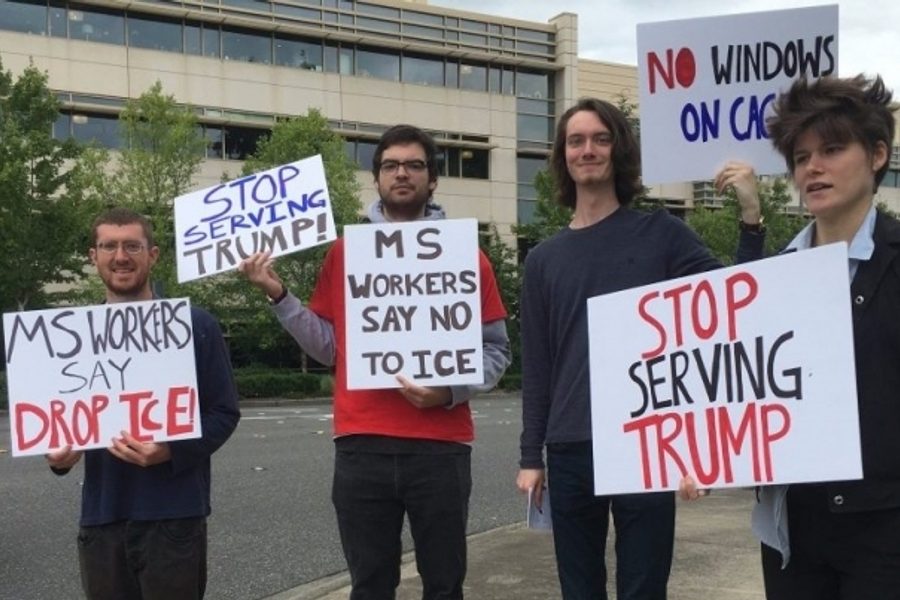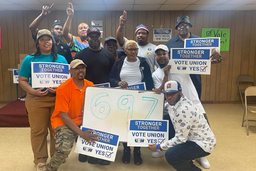Here’s How Tech Workers and Flight Attendants Are Resisting Immigrant Family Separation
Chris Brooks

The brutal and wildly unpopular Trump administration policy that separated thousands of children from their immigrant parents triggered widespread protests.
It also provoked resistance from workers whose jobs are crucial to carrying it out.
Immigration and Customs Enforcement (ICE) and U.S. Customs and Border Protection (CBP) don’t operate in a vacuum. They depend on a host of products and services — including technology produced by software engineers and travel assisted by flight attendants.
By choosing to take a stand, these workers — some union, some nonunion — added their efforts to a national push that got the administration to suspend its policy, though thousands of children who were already separated have yet to be reunited with their families.
Tech workers
Amazon, Microsoft, and Salesforce all have lucrative contracts with immigration enforcement agencies, like ICE and CBP. What for? The details aren’t public, but the possibilities are alarming.
Amazon and Microsoft are developing facial recognition technology that could identify individuals in crowds, at protests, on the street, and even through drone cameras. Amazon is already marketing these tools to police departments and federal agencies. Workers are concerned that they could be helping ICE to use them.
Tech workers at all three companies are petitioning their employers to develop ethical guidelines for how their services are used by government agencies. So far they haven’t met with the same success as Google employees, who in June pressured their employer into canceling a contract with the Pentagon’s drone program.
Google caved after several dozen employees publicly resigned and thousands more signed onto a letter protesting the use of Google’s artificial intelligence technology to analyze footage taken by military drones.
What makes these actions novel is that the tech industry is almost universally nonunion, leaving workers fearful of retaliation.
“For good, not for harm”
Three-hundred employees signed a public letter in June calling on Microsoft to terminate its contracts with ICE, after the company’s $19.4 million deal with the agency caught media attention.
An official Microsoft marketing blog had gone viral, boasting that the company’s contract to provide artificial intelligence technology to ICE could “accelerate facial recognition technology.”
Employees were livid. “As the people who build the technologies that Microsoft profits from, we refuse to be complicit,” the letter read. “We are part of a growing movement, comprised of many across the industry who recognize the grave responsibility that those creating powerful technology have to ensure what they build is used for good, and not for harm.”
Employees also called on Microsoft to commit not to work with clients accused of violating international human rights law. The United Nations human rights office had ruled that the family separation practices violated international law.
Feeling the heat, Microsoft backpedaled, denying that any of its services have been used for biometric surveillance by ICE.
Facial recognition
Meanwhile, after the ACLU published a report in May that Amazon “has developed a powerful and dangerous new facial recognition system and is actively helping governments deploy it,” several hundred technology workers at Amazon signed a letter demanding that the company terminate its contracts with law enforcement agencies.
The ACLU had examined marketing materials that Amazon sent to police agencies around the country. Nicole Ozer, technology and civil liberties director for the ACLU of California, described them to the press as “a user manual for authoritarian surveillance.”
Amazon employees also called on their employer to stop providing infrastructure for Palantir Technologies, a $20 billion CIA-connected data-mining firm owned by billionaire Peter Thiel that was contracted to create the immigrant tracking service for ICE.
And 650 employees of the database giant Salesforce signed another June letter, this one calling on CEO Marc Benioff to examine the use of Salesforce products by U.S. Customs and Border Protection and to ensure that its technology was not being used to facilitate Trump’s “destructive” policies.
Quiet meetings
This tech revolt was months in the making. After the ACLU report came out, “there was a group of workers who knew each other through connections outside of work,” said one Amazon worker who spoke on the condition of anonymity, “who were meeting to talk about the use of facial recognition technology by police and what could be done about it.”
The family separations gave those meetings a new sense of urgency.
“A group started working on a letter collaboratively,” the worker said. “Then the news broke about Microsoft employees doing the same thing, because Microsoft was selling services directly to ICE. The decision was made to capture the moment and release the letter.”
The letter said, in part, “We learn from history, and we understand how IBM’s systems were employed in the 1940s to help Hitler. IBM did not take responsibility then, and by the time their role was understood, it was too late. We will not let that happen again.”
Initially the letter was published on the company’s internal server with no signers, but then workers began signing on. In a week the number of signatures reached 400, including some senior software engineers.
Flight attendants
In his 29 years as a flight attendant and active union member, Hunt Palmquist always assumed that if he saw something objectionable or suspicious, he would act.
But that idea was put to the test when an ICE agent, chaperoning five children, boarded his flight from San Antonio to McAllen, Texas.
“I saw a kid, about five years old,” Palmquist said. “He just had tears running down his cheeks and his chin was quivering, but he was almost stone-faced, like he was trying to hold back the rest of his tears.”
They were already in the air by the time Palmquist spoke with the ICE agent and confirmed that he was taking the children to one of the large facilities where children were being warehoused in cages.
“I couldn’t understand how something like this could get by someone, until it got by me,” said Palmquist. “The thing that bothers me every day is that I didn’t act sooner.”
Grounding ICE
After a few days’ reflection, Palmquist wrote an editorial for the Houston Chronicle.
“As a result of what I witnessed,” he wrote, “I have made a decision that if I’m ever assigned to a flight with children who’ve been separated from their families, I will immediately remove myself from the trip due to the nature of this unconscionable act by my government and my employer’s complicity.
“I have told my story to many of my flight attendant colleagues and they have pledged to do the same.”
Palmquist’s editorial was picked up in international press. Flight attendants shared it on social media, where hundreds pledged that they too would refuse a flight assignment if federal agents transporting children boarded.
That would ground the plane. “As we used to say during the strike,” said Palmquist, who once coordinated a strike for his union, “if the flight attendants are not working, the metal doesn’t move.”
He believes it was these pledges from “hundreds of my co-workers” that forced the airlines to act. Within two days of the Houston Chronicle publication, multiple airlines — including his own employer, which he asked us not to name — released statements telling the federal government not to use their flights to transport detained immigrants or their children.
This article first appeared on Labor Notes.
Chris Brooks is a labor journalist and organizer. He currently works as the field director at the NewsGuild of New York.







